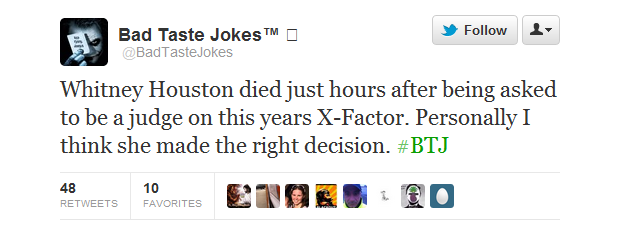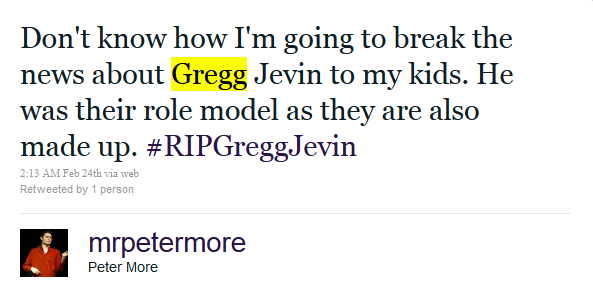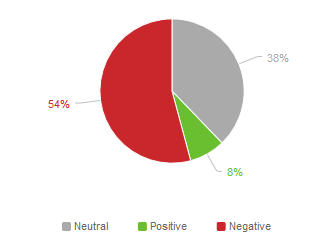The 20 Most Liked Posts on Instagram
By Gemma JoyceJul 19
Join us and boost your social media potential with our data-led event
Twitter was ablaze with heartfelt discussion last week, as Friday saw the tragic death of Gregg Jevin, who was cruelly taken away from us.
Jevin will forever be remembered for… well, nothing, because he never actually existed.
It all started when the comedian Michael Legge, who has around 10,000 followers, tweeted about the lament of Gregg’s death.

His followers quickly picked up on the tragedy, citing fond memories of the fictional man and began to use the #RIPGreggJevin hashtag.
It wasn’t long before a whole host of other comedians joined in the fun, with Charlie Brooker, Dara O Briain and Gary Lineham all contributing their obituaries to the recently deceased.

We’ve used Brandwatch to take a look at how the trend developed. You can see that the top tweeters were largely comedians, with joke profiles and famous stand-ups like Robin Ince and Brian Limond commenting on the death.
Humour is often the main driver behind trends, and even with the deaths of Whitney, Jacko and Winehouse, the most popular tweets and focal points of discussion were the more silly (admittedly poor taste) jokes that inevitably followed in the wake of such high profile deaths.

As is the case with so many trends, the #RIPGreggJevin hashtag – which was the top UK trend by 3pm on Friday – was fuelled by humour, with retweets and sharing of jokes the primary catalyst behind the spread of the news.

From its origin at 10am, it took off at around 1pm, when @RadioTimes featured faux Jevin-inspired documentaries in their listings and companies began running competitions and tweeting homages about the man.
Between 2pm and 3pm, the game had taken off, with over 400 tweets broadcast in that hour. Waterstone’s, The Telegraph and BBC Worldwide all got in on the act, and the Royal Albert Hall even described a memorial gig they would be hosting for Gregg.

Twitter and social media in general has opened up the face of companies, so that previously professional and faceless corporations are now able to break down this impenetrable façade and engage with consumers directly, responding quickly to these types of phenomena and getting involved in the discussions.
A look at the buzz also shows how short-lived trends can last. The meteoric rise seen in the early afternoon was echoed by the instant downfall not long after.
These trends do not capture the imagination of tweeters for long, and all mentions of Gregg Jevin had basically disappeared by Sunday.

This didn’t stop an @Gregg_Jevin account from being created, and users talking about Jevin incessantly.
Dozens of users tweeted multiple times about him, with a small collection of people becoming essentially ‘brand advocates’ for the Jevin scenario.
Looking through this data, although it’s a fictional death and not about brands, it does provide some insight as to how quickly, and in what form these trends can begin and spread.
An another interesting aspect to inspect is the automated sentiment analysis with this query we’ve made. Here at Brandwatch we’re fully aware of the shortcomings of automated sentiment analysis, and in the case of humorous and sarcastic tweets it can be incredibly difficult for a machine to understand that.

Even human analysts are unable to universally agree on tone, so classifying the sentiment of Jevin tweets is tough.
Brandwatch segments the data into largely negative tweets, with over half the mentions being recognised as negative in sentiment.
This is mainly as the tweets contain negative words, and express sadness at fate’s cruel choice to take poor Gregg Jevin away from us. It is unable to determine whether these tweets are in jest or not.
To read how we tackle this tricky area, you can read our document on our approach to sentiment analysis here.
So, there we have it. Some food for thought on how
Offering up analysis and data on everything from the events of the day to the latest consumer trends. Subscribe to keep your finger on the world’s pulse.
Consumer Research gives you access to deep consumer insights from 100 million online sources and over 1.4 trillion posts.
Existing customer?Log in to access your existing Falcon products and data via the login menu on the top right of the page.New customer?You'll find the former Falcon products under 'Social Media Management' if you go to 'Our Suite' in the navigation.
Brandwatch acquired Paladin in March 2022. It's now called Influence, which is part of Brandwatch's Social Media Management solution.Want to access your Paladin account?Use the login menu at the top right corner.



